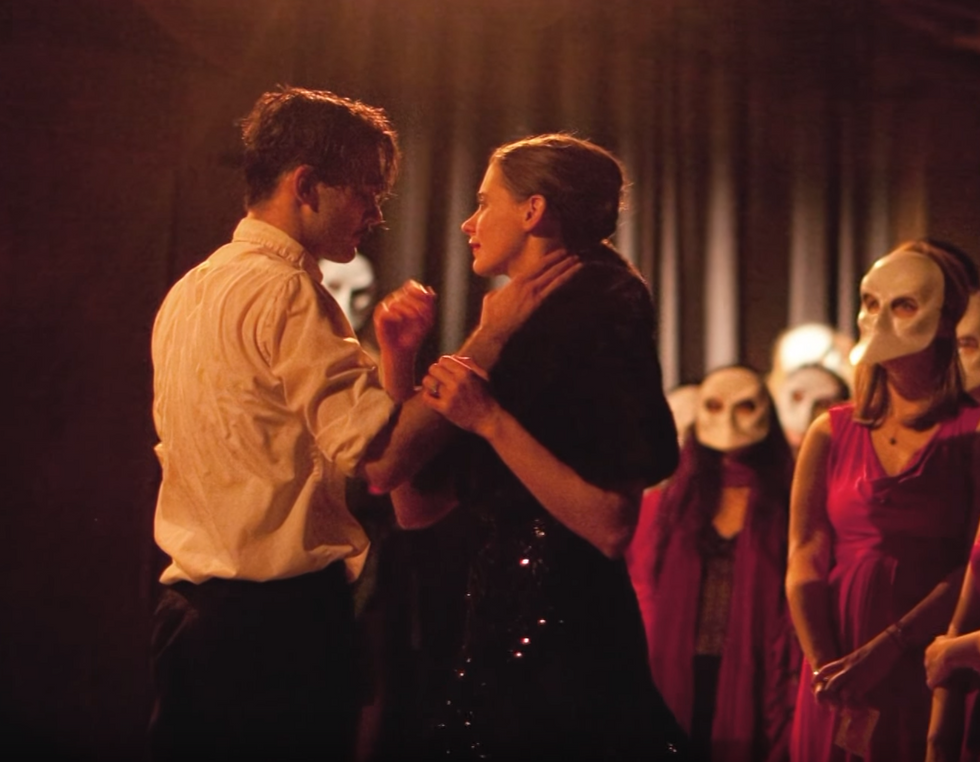You slip on your mask and enter an elevator, becoming just one in a crowd of shielded audience members. A man in the corner of the elevator, dressed up in a fancy, old-fashioned tuxedo, introduces you to the dimly-lit, mind-bending experience you are about to have. The elevator opens, someone steps off, and just as you’re about to follow, the man places an arm in front of you, closes the elevator doors, and calmly says that this is an individual trip each person must take. This is “Sleep No More.”
The immersive play with very little words but lots of movement emphasizes the characters found in Shakespeare’s Macbeth, bringing them to life as more than plot devices. Here, each actor has a backstory, a motive, and it shines through their wanderings around the dark warehouse on 27th Street.
In the small lounge before one fully commits to the play, where music from the 1920s pumps through speakers as slow-talking actors laugh in their glitzy dresses and tuxedos, you are told the best way to experience “Sleep No More” is by picking a cast member to hold onto. You will follow him or her around the set, up and down flights of stairs, until you get the gist of what is happening before the final death scene. Those who are dressed up tell you all this, carrying trays of liquor in one hand and feathered hats in another. Yes, even they are characters in this rendition.
Take the Gentlewoman, for example, a lesser character who is most remembered in the play for showing the doctor that Lady Macbeth sleepwalks. If you were to catch this woman in the hallway, her white uniform starched to perfection, you could follow her into the office, where she smooths her skirt, rifles through some papers, and picks up the Doctor’s kit. She pauses in the mirror on the way out of the office to fix her hair and looks around self-consciously before hurrying down a stairwell to deliver the bag.
In this short sequence, you get a glimpse of who the Nurse is. You understand her youth from the short uniform skirt that shows off her legs. You can tell she doesn’t like her job by her curiosity in the office, her desire to see herself in the mirror. In “Sleep No More,” the Nurse is more defined, which is both a strength of this interpretation and a weakness.
In following one character, the Nurse in this case, what do you miss? As she organizes papers on the Doctor’s desk, as if begging you to get bored and leave her, another character may be murdered.
Did you get to see and understand the look of friendship that passes between Duncan and Macbeth? Are all parts truly created equal if you miss pivotal moments between characters as you chase the Nurse in between stories of the warehouse-hotel?
Perhaps not, but the interpretation presented in “Sleep No More” brings more life to Shakespeare’s Macbeth. Why does Lady Macbeth cry out, “Come to my woman’s breasts,/And take my milk for gall” when pleading for the courage to commit treason (1.5.47-48)? “Sleep No More” nudges you in the direction of a nursery and a bloody child in a dark bath to figure that out.
These are the questions that arise from “Sleep No More,” questions whose answers expose how the experience is simultaneously connected to and far from the original play. Perhaps it isn’t for die-hard Macbeth fans who want to see a cut-and-dry version of the play. It isn’t for those who cannot afford the hefty ticket price, either, as they will want to return to the show to follow other characters and see what more is exposed.
Rather, “Sleep No More” is for those familiar with the play who crave a new experience to compare to other interpretations. You should wear your walking shoes and be prepared to elbow audience members out of the way, claw to the front of the action, and take the hand of anyone who offers. As you are told before you enter “Sleep No More,” fortune favors the bold, so be bold.
You can find out more about “Sleep No More” and purchase tickets at their website here.





















